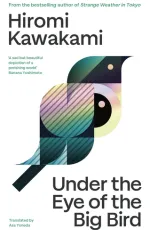
Under the Eye of the Big Bird by Hiromi Kawakami, translated by Asa Yoneda – reviewed by K. Lin
This nominee of the International Booker Prize, originally published in 2016, offers a bleak speculation of humanity's future. A soft science fiction with fantastical elements, the style of this novel is reminiscent of Kazuo Ishiguro's Never Let Me Go, with its unsophisticated language and vague technology. There is no particular narrative surrounding anyone throughout the 14 chapters, or rather, independent short stories under the same universe, only with roles that return now and then; still, those isolated fragments come together to expand the novel's grand worldview, covering a multitude of sociological themes.
Yoneda’s translation succeeded in presenting the nuance of linguistic shifts between different sections throughout. She captures the atmosphere, paradoxically, by taking liberties: for example, the titular chapter is translated as "Under the Eye of the Big Bird", from the original 大きな鳥にさらわれないよう, literally "to avoid being swept away by the big bird".
A common complaint is the narrative fragmentation that sets this novel apart, which can be difficult to cope with (as is the "system" of human civilisation in the text). Still, it's a worthy read if you want an avant-garde presentation of what we could become one day.
Under the Eye of the Big Bird by Hiromi Kawakami, translated by Asa Yoneda – reviewed by Kai Chase
“19, what do you think hate is?”
Hiromi Kawakami’s Under the Eye of the Big Bird is an understated, attentively painted portrait of a very possible near-future. The novel is persistently polyvocal, and its many threads patiently co-exist before they are interwoven in the second half.
The novel is most dazzling in its moments of psychological erosion. Humanity’s defining traits – sex, love, hate – are made strange in a world exhaling its final breath. Its plaintive visions of a dying race offer a chilling read of the present.
Under the Eye of the Big Bird is dreamy, insistent, and unsettling. Voices, both artificial and human, or near-humans, flow seamlessly and indistinctly from one to the other: in a world increasingly dominated by technology and anthropomorphized artificial intelligence, where does the digital end and where do we begin?
A very relevant read in an increasingly complex modern era.